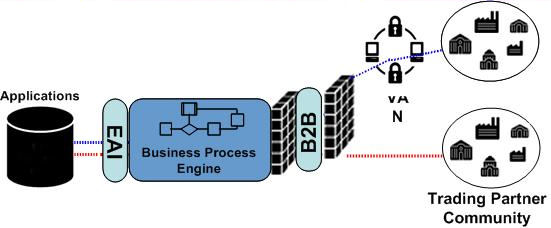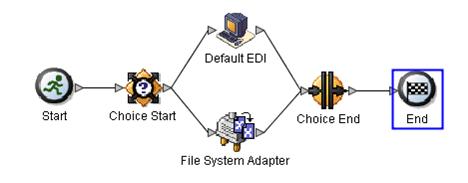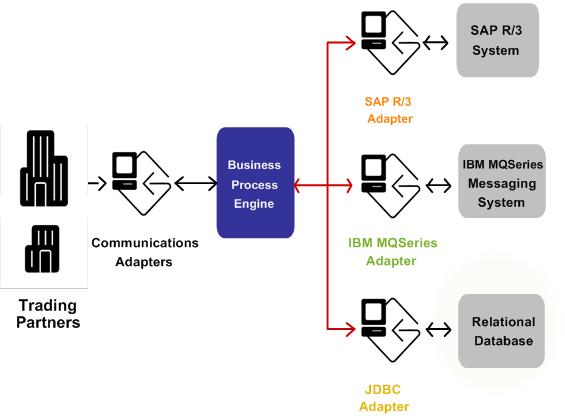
IBM watsonx for Enterprise Asset Management
IBM watsonx for Enterprise Asset Management: Leveraging AI to Boost Efficiency and Performance Enterprise Asset Management (EAM) is undergoing a significant transformation,
Sterling B2B Integrator is a transaction engine that runs the processes you define and manages them according to your business requirements.
Together, these features enable you to configure the components that enable you to meet your evolving application integration requirements.
The resulting pockets of integrated applications across a landscape of largely unintegrated and unmanaged applications leave you ill-prepared to keep up with today’s demands. You need ambitious new ways to conduct e-business to retain your competitive edge through increased efficiency.
Application integration has been crucial since the early days of e-business, but never to the degree that it is today. Accelerated demands of the global marketplace are forcing businesses to adapt constantly to changing communication requirements, shrinking product development cycle times, and increased competitive pressures.
While past approaches to integration brought important efficiencies, they do not represent complete end-to-end integration. Like many firms, you probably have in place limited-purpose middle-ware such as file transfer, Electronic Data Interchange (EDI), message queuing, Internet B2B gateways, direct database access, Enterprise Application Integration (EAI) brokers, and custom-coded interfaces.
A backlog of e-business initiatives, growing internal and external interaction demands, and meeting regulatory and industry mandates can cause business challenges for integration.
Our modular licensing and implementation model enables you to make quick progress against backlog by starting small and incrementally introducing enhanced automation to your processes. This method helps you avoid the pain of a revolutionary upheaval.
External requirements to deploy new standards-based XML-centric B2B protocols
Need for deeper levels of internal application integration
Sterling B2B Integrator is designed to operate with emerging standards and protocols, enabling you to add the appropriate components to your system when the requirement arises.
The user interface includes wizard-driven configuration and deployment steps, eliminating the requirement for custom coding. This accelerates your transition times and return on investment, as a result of which your company can focus on higher-level business problems.
The product architecture lets you integrate new procedures into your processes on the fly. The tracking capabilities provide a 360-degree view of customer transactions, including a single console facilitating real-time monitoring of your processes and transactions.
Regulatory initiatives and industry mandates such as AS3 document transport, HIPAA compliance (Health Insurance Portability and Accountability Act), SWIFT, RosettaNet implementation guidelines, and EBICS are some of the business drivers that require advanced integration.
In the United States, if you are an organization in the utilities, logistics, or financial industries, you are likely facing deregulation concerns. In general, organizations in Europe and Asia, as well as in the U.S. automotive industry, must be ebXML-compliant. And U.S. federal mandates related to corporate accountability, such as the Sarbanes-Oxley Act, may be increasing your internal and external application and partner integration requirements.
Sterling B2B Integrator enables you to rapidly modify your processes or deploy new technology when the requirement arises.
Changes that are driven by new requirements such as new data formats and communication protocols, new business exchanges, and a broad range of partners that vary in size, type, and sophistication, require your organization to be flexible and adapt to changing and varied situations quickly and efficiently.
In order to be competitive, you must be responsive to the constant changes occurring within your trading partner community.
Sterling B2B Integrator:
Works over almost any communication protocol, including HTTP, HTTPS, FTP, FTPS, SMTP, SOAP, EDIINT (AS1, AS2, and AS3). Therefore, you have the flexibility to respond to changes in communication methods (async and bisync communications are supported through IBM® Sterling Connect:Enterprise® interoperability)
Provides scalability to meet fluctuations in transaction volume
Enables end-to-end order visibility for tracking transactions throughout the lifecycle of an order and ensuring that orders are never lost
Interfaces with B2B exchanges, marketplaces, and services such as RosettaNet, Sterling Information Broker®, and the GSX and IBM networks
You can also use it to facilitate e-business with your trading partners for a vast assortment of transactions, including EDI, e-mail, and reliable bulk file management. You can build human intervention points, such as approvals, into your processes and set up self-service access to information across trading partner systems. You can also:
The following figure illustrates the path that the data takes from your applications to your trading partner community. Enterprise Application Integration (EAI) components and B2B services facilitate the transfer of information, while the processing engine, the Business Process Engine, manages everything.

Data transformation is the cornerstone of electronic commerce. With Sterling B2B Integrator, you can manipulate data transformation easily.
Supported data formats include Electronic Data Interchange (EDI), positional, variable-length-delimited, Japanese Center for Informatization of Industry (CII), and Extensible Markup Language (XML). Using Structured Query Language (SQL), Sterling B2B Integrator can read, write, and update databases.
Sterling B2B Integrator provides sophisticated transformation logic, including if-then-else, boolean logic, conditional operators, look-up tables, user-defined constants, and user exits.
With support for pre-existing and emerging standards in place, you are prepared to meet new requirements as they develop. You can add complexity to existing structures and build new structures into your translation processes using the configurable components.
A Java translation engine provides scalability, fault tolerance and reliability—all of which powerful assets for sophisticated translations. You can respond quickly to changing translation requirements, improving your quality of service through data integrity.
A graphical user interface is provided for the design and collaborative development of data transformation maps. This interface simplifies map creation by enabling you to build translation maps using point-and-click technology. You can reuse the maps that you have already created, cutting data management costs.
The Graphical Process Modeler (GPM) depicts predefined system activities by using icons, so you can easily create links between them to design comprehensive process flows, called business process models.
You can achieve your automation goals with reusable code that you can configure through the easy-to-use graphical interface.
The GPM converts your graphical representation of business processes to well-formed business process code, saving you the effort of writing code. Your process models are immediately executable, and the process development cycle time is short.
You can perform a search in the system by process, partner, and document content, and can configure persistence into your processes to ensure message delivery.
The following figure shows a simple sample business process model as it is displayed in the GPM.

To reduce costs, you must replace manual intervention points in your business processes with automated capabilities.
Exception management such as escalation and transaction reconciliation, error handling, and content-based routing are classic examples of automated capabilities.
With Sterling B2B Integrator, you can create online forms for reviewing, entering, and otherwise interacting with the data in a process. You can even enable your business partners to access custom-created online forms so that they can interact as part of your process.
For example, you can create self-service payment, order, and shipment status forms, and use them to improve partner and customer collaboration through secure, selective data sharing online.
Even when your processes are integrated, day-to-day monitoring and management of activities can be complicated and redundant. To eliminate complications and get maximum value from your integration technology, you need a central hub from where you can ensure end-to-end transaction visibility, configure and manage operations, and transactions.
Track processing history
View transaction details and real-time system events
Obtain processing state information
To provide full-spectrum transaction visibility, Sterling B2B Integrator interoperates with other enterprise system management products, including IBM Tivioli, BMC Performance Manager, and Computer Associates' Unicenter.
You can integrate applications by using batch, synchronous, and asynchronous processes to support your end-to-end integration goals.
Allows you to incorporate messaging, human interventions, and file and database activities within your integrated business process models
Offers non-invasive, rapidly deployable messaging and data storage systems, as well as application adapters to facilitate enterprise resource planning goals
Can be easily integrated with Simple Network Management Protocol (SNMP) network management, Lightweight Directory Access Protocol (LDAP) directories, Web services, and more
The following figure shows the processing engine coordinating the communications to your trading partners through communication adapters. This is based on data transformation and processing involving other integrated systems, all accessed through adapters.

Browse Categories
Share Blog Post

IBM watsonx for Enterprise Asset Management: Leveraging AI to Boost Efficiency and Performance Enterprise Asset Management (EAM) is undergoing a significant transformation,

Building a Connected Enterprise for Ingram Content Group What Our Clients Say “The Pragma Edge team’s collaboration and expertise were key to

IBM Sterling for Modern B2B Integration, EDI, and Managed File Transfer: A Practitioner’s Guide Introduction B2B integration today is more than just
| Cookie | Duration | Description |
|---|---|---|
| cookielawinfo-checkbox-analytics | 11 months | This cookie is set by GDPR Cookie Consent plugin. The cookie is used to store the user consent for the cookies in the category "Analytics". |
| cookielawinfo-checkbox-functional | 11 months | The cookie is set by GDPR cookie consent to record the user consent for the cookies in the category "Functional". |
| cookielawinfo-checkbox-necessary | 11 months | This cookie is set by GDPR Cookie Consent plugin. The cookies is used to store the user consent for the cookies in the category "Necessary". |
| cookielawinfo-checkbox-others | 11 months | This cookie is set by GDPR Cookie Consent plugin. The cookie is used to store the user consent for the cookies in the category "Other. |
| cookielawinfo-checkbox-performance | 11 months | This cookie is set by GDPR Cookie Consent plugin. The cookie is used to store the user consent for the cookies in the category "Performance". |
| viewed_cookie_policy | 11 months | The cookie is set by the GDPR Cookie Consent plugin and is used to store whether or not user has consented to the use of cookies. It does not store any personal data. |
Thank you for submitting your details.
For more information, Download the PDF.
Thank you for registering for the conference ! Our team will confirm your registration shortly.
Invite and share the event with your colleagues
IBM Partner Engagement Manager Standard is the right solution
addressing the following business challenges
IBM Partner Engagement Manager Standard is the right solution
addressing the following business challenges
IBM Partner Engagement Manager Standard is the right solution
addressing the following business challenges